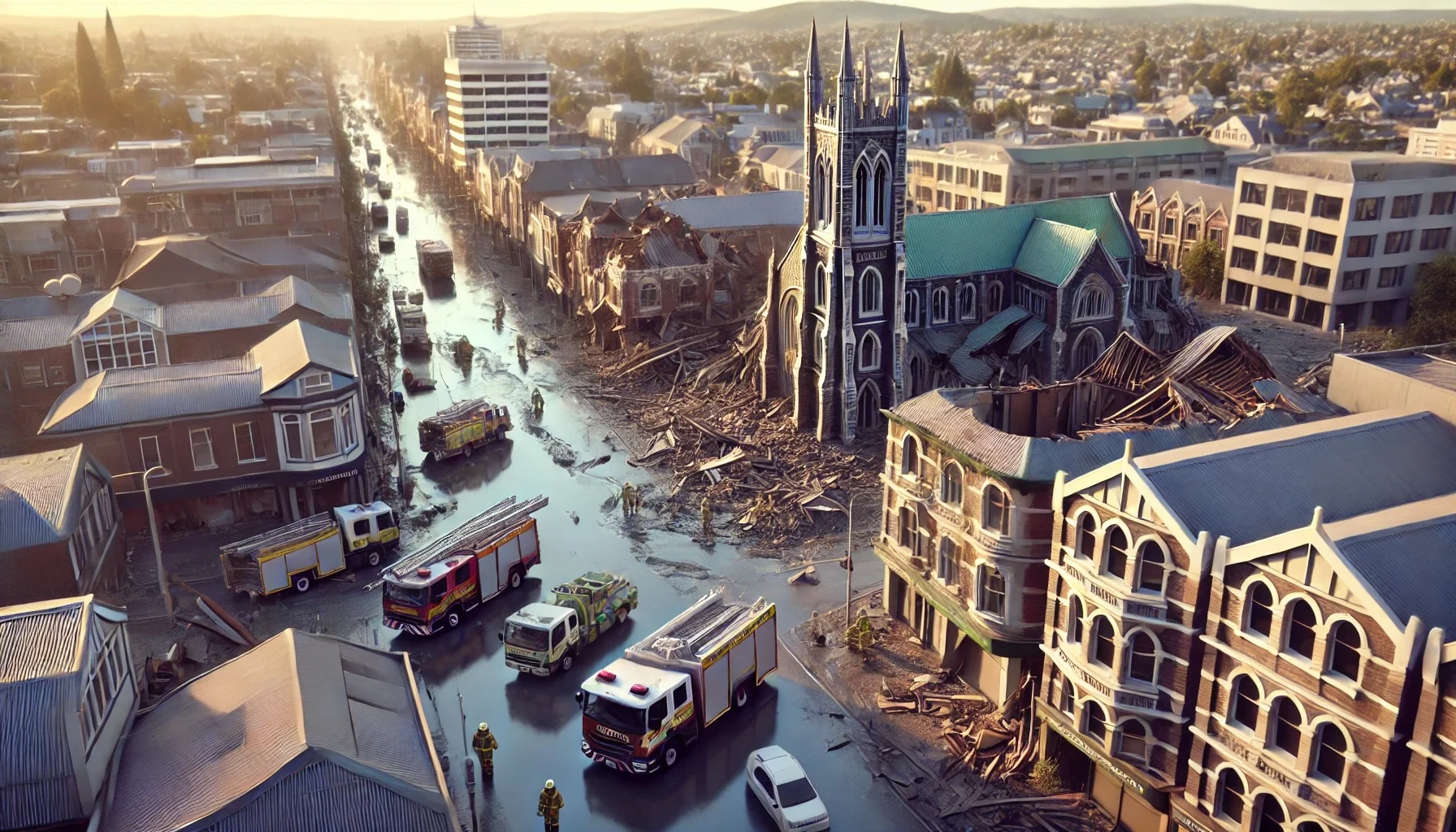
The 2010 Canterbury Earthquake
by: The Calamity Calendar Team
September 4, 2010
In the early hours of September 4, 2010, a powerful earthquake ripped through the Canterbury region of New Zealand, altering the lives of its residents and the landscape itself. The quake, registering a magnitude of 7.1, originated near the small town of Darfield, just 40 kilometers west of Christchurch. While the epicenter was rural, the seismic waves didn’t respect boundaries, striking deep into the heart of Christchurch and beyond.
Geological Background: A Fault Unveiled
Before the earthquake, the region was not known for major seismic activity. However, New Zealand sits atop the Pacific and Australian tectonic plates, making it one of the most seismically active areas in the world. The 2010 Canterbury earthquake was caused by movement along a previously unknown fault line, now referred to as the Greendale Fault. This fault was buried beneath the Canterbury Plains, a fertile area thought to be geologically stable.
When the fault ruptured, it caused the ground to lurch violently. In some places, the earth shifted by up to five meters horizontally, cracking roads, fences, and even the land itself. The fault’s sudden appearance highlighted the complexities of New Zealand's geology and the challenges in predicting such events.
The Immediate Impact: Christchurch and Beyond
The earthquake caused widespread damage across the Canterbury region, with Christchurch bearing the brunt. Buildings that had stood for decades crumbled in seconds. Historic structures, including the iconic Christchurch Cathedral, suffered extensive damage. Suburbs on the city’s eastern side were particularly hard-hit by liquefaction, where the shaking ground caused water-saturated soils to behave like a liquid, engulfing streets and homes. In areas like Kaiapoi and Bexley, the ground subsided, leaving homes and infrastructure severely compromised.
The effects extended beyond Christchurch. The small towns of Darfield, Rolleston, and Lincoln experienced significant damage, with many homes rendered uninhabitable. Rural areas saw widespread destruction of farmland, and the quake disrupted essential services like electricity, water, and sewage across a vast area. The financial impact was staggering, with initial damage estimates reaching NZ$4 billion, and total costs eventually rising as subsequent aftershocks continued to wreak havoc.
The Science of Seismicity: Understanding the Aftershocks
The September 4th earthquake was not an isolated incident but the beginning of a prolonged seismic sequence. Following the main event, thousands of aftershocks rattled the region, including a major aftershock on Boxing Day in December 2010, which caused further damage in already weakened Christchurch. These aftershocks were reminders of the earth's continuing instability, each one a potential disaster in its own right.
Thanks for subscribing!
The most devastating of these aftershocks came on February 22, 2011, when a magnitude 6.3 earthquake struck directly beneath Christchurch. Though smaller in magnitude, it was much closer to the surface and the city, leading to catastrophic damage and the tragic loss of 185 lives. The February quake compounded the destruction and left an indelible mark on New Zealand’s history.
Lessons Learned and Lasting Impact
The Canterbury earthquake sequence fundamentally changed how New Zealanders think about seismic risks. The discovery of the Greendale Fault led to a reevaluation of the seismic hazards across the country. Building codes were updated, emphasizing the need for earthquake-resistant designs, even in areas previously considered low-risk.
The earthquakes also transformed the landscape of Christchurch. Large portions of the city’s eastern suburbs were deemed uninhabitable and were eventually abandoned. In the years that followed, Christchurch embarked on a massive rebuilding project, reshaping the city with new, more resilient infrastructure. However, the emotional and economic scars remain, and the memory of the earthquakes continues to influence how New Zealand prepares for future natural disasters.
A Community Reborn
Despite the devastation, the Canterbury earthquake also showcased the resilience of the region's communities. In the immediate aftermath, neighbors helped each other navigate the wreckage, and volunteers from across the country poured into Christchurch to aid in recovery efforts. This sense of unity and determination has been a cornerstone of the rebuilding process.
Today, Christchurch stands as a symbol of both the destructive power of earthquakes and the strength of human resilience. The lessons learned from the Canterbury earthquakes continue to shape New Zealand’s approach to disaster preparedness, ensuring that future generations are better equipped to face the inevitable challenges that come with living in an earthquake-prone land.
Stay in the Loop!
Become a Calamity Insider and get exclusive Calamity Calendar updates delivered straight to your inbox.
Thanks! You're now subscribed.